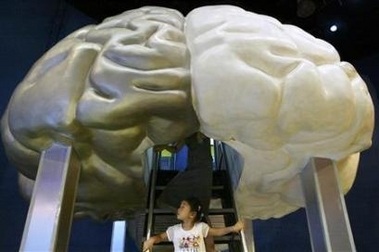Brain differences detected in migraine sufferers
Updated: 2007-11-21 09:17
WASHINGTON -- People who get migraines have structural differences in their brains notably in the cortex area that processes pain and other sensory information from the body, scientists said on Monday.
|
|
The researchers, whose findings were published in the journal Neurology, said it is unclear whether these brain differences actually cause migraines or are themselves caused by these severe, recurrent headaches.
The researchers performed brain scans on 24 people who had a long history of frequent migraines -- about four per month for 20 years -- and 12 people who did not get migraines.
The somatosensory cortex -- the area of the brain that detects sensations like pain, touch and temperature in various parts of the body -- was 21 percent thicker in the people who got migraines compared to those who did not.
The biggest difference was in the part of the cortex responsible for processing sensory information from the head and face, Dr. Nouchine Hadjikhani of Massachusetts General Hospital, who led the study, said in a telephone interview.
Hadjikhani said the study illustrated the seriousness of the migraine. "It has to be taken seriously because it can induce changes in your brain," she said.
Migraines are a type of painful headache commonly accompanied by nausea, vomiting and heightened sensitivity to light and sound. Women are three times more likely than men to experience these headaches. Many people who get them have a family history of migraines.
"The more we understand about the pathophysiology of migraine, the better we will be able to design drugs that work. At the moment, there is no drug for prevention that works well," Hadjikhani said.
Dr. David Dodick, a professor of neurology at the Mayo Clinic who was not involved in the study, said the study shows that migraines are a brain disorder. "And it shows that migraine has some durable, long-lasting morphological or structural changes in the brain over time," Dodick said.
Dodick said he would be interested to know whether people who get migraines less frequently have the same brain changes.
Hadjikhani said one possibility is that repeated, long-term overover stimulationstimulation of sensory fields in the cortex may cause it to become thicker over time. Another possibility is that people predisposed to migraines already have this thicker cortex, Hadjikhani said.
According to the US National Institutes of Health, researchers suspect migraines are caused by inherited abnormalities in genes that control certain cells in the brain. For many years, scientists had thought migraines were linked to the dilation and constriction of blood vessels in the head.
Dr. Seymour Diamond, executive chairman of the National Headache Foundation and head of the Diamond Headache Clinic in Chicago, said in an interview the findings further confirm that migraines are a neurological disease.
Researchers have seen differences in cortex thickness in other diseases as well. It is thinner, for example, in people with multiple sclerosis, Alzheimer's disease and autism.
|
|
|
||
|
||
|
|
|
|
